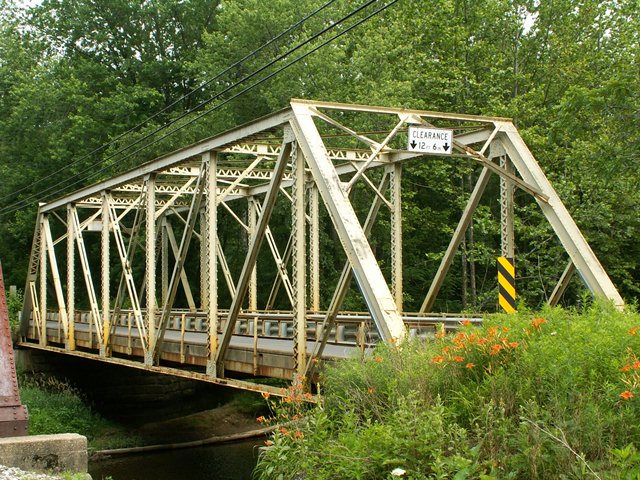We Recommend:
Bach Steel - Experts at historic truss bridge restoration.
BridgeHunter.com Phase 1 is released to the public! - Visit Now
Sugarcreek Bridge
Buttermilk Hill Road Bridge

Primary Photographer(s): Nathan Holth
Bridge Documented: July 1, 2006
Sugarcreek: Venango County, Pennsylvania: United States
1920 By Builder/Contractor: Groton Bridge Company of Groton, New York and Engineer/Design: Karl A. Miller
1981
123.0 Feet (37.5 Meters)
126.0 Feet (38.4 Meters)
15.7 Feet (4.79 Meters)
1 Main Span(s)
604010010009340

View Information About HSR Ratings
Bridge Documentation
View Archived National Bridge Inventory Report - Has Additional Details and Evaluation

This bridge is right next to the Sugarcreek Railroad Bridge.
This attractive and unaltered through truss bridge sits next to a railroad truss bridge, making this a unique setting. To find two small single span truss bridges side by side is very rare. You can find multiple truss bridges next to each other on larger, urban areas like Pittsburgh, but not usually out in the county on smaller rivers and creeks like this. Long ago, this may have been common, but today, in most cases, the highway half of the bridge pair has been demolished. What is ironic here, is that PennDOT decided to rehabilitate this bridge, a decision which PennDOT almost never makes. Yet in this case, the railroad bridge is being planned for replacement by the railroad! Usually, the railroad bridges are spared demolition. Thus the apparant planned outcome here is the reverse of what one would expect. Sugarcreek was a unique setting of a two single-span Pratt through truss bridges side by side, one for the railroad and the other for the highway. It is a truly beautiful scene. It also represents a scene that would have been much more common in the past. As such, the preservation of both structures should have been paramount here at Sugarcreek.
The highway bridge is a Pratt through truss with riveted connections. It was built in 1920 by the Groton Bridge Company. V-lacing is present on the verticals, on the sway bracing, and under the top chord and end post. Original angle railings remain in place behind modern Armco railings. The floor beams and deck stringers are original. The deck is concrete with an asphalt wearing surface. The portal bracing is an a-frame design.
Information and Findings From Pennsylvania's Historic Bridge InventoryDiscussion of Bridge The 1920, riveted, single span, 126'-long, Pratt thru truss bridge is supported on ashlar abutments with flared wingwalls. The trusses are composed from built up members. The bridge, a late and undistinguished example of a common technology, has no innovative or distinctive details. Riveted truss bridges have been used on Pennsylvania highways since ca. 1890. Earlier examples or those with innovative details better represent the technology. The bridge is neither historically nor technologically significant. Discussion of Surrounding Area The bridge carries a 2 lane road over a stream in a predominantly rural area. Just to the south is a pin connected, Pratt thru truss Conrail railroad bridge spanning the same stream. To the west is a small, undistinguished, early 20th century residential development. To the east is wooded and sparsely developed. The area does not have historic district potential. Bridge Considered Historic By Survey: No |
![]()
Photo Galleries and Videos: Sugarcreek Bridge
Bridge Photo-Documentation
Original / Full Size PhotosA collection of overview and detail photos. This gallery offers photos in the highest available resolution and file size in a touch-friendly popup viewer.
Alternatively, Browse Without Using Viewer
![]()
Bridge Photo-Documentation
Mobile Optimized PhotosA collection of overview and detail photos. This gallery features data-friendly, fast-loading photos in a touch-friendly popup viewer.
Alternatively, Browse Without Using Viewer
![]()
Maps and Links: Sugarcreek Bridge
Coordinates (Latitude, Longitude):
Search For Additional Bridge Listings:
Bridgehunter.com: View listed bridges within 0.5 miles (0.8 kilometers) of this bridge.
Bridgehunter.com: View listed bridges within 10 miles (16 kilometers) of this bridge.
Additional Maps:
Google Streetview (If Available)
GeoHack (Additional Links and Coordinates)
Apple Maps (Via DuckDuckGo Search)
Apple Maps (Apple devices only)
Android: Open Location In Your Map or GPS App
Flickr Gallery (Find Nearby Photos)
Wikimedia Commons (Find Nearby Photos)
Directions Via Sygic For Android
Directions Via Sygic For iOS and Android Dolphin Browser
USGS National Map (United States Only)
Historical USGS Topo Maps (United States Only)
Historic Aerials (United States Only)
CalTopo Maps (United States Only)

